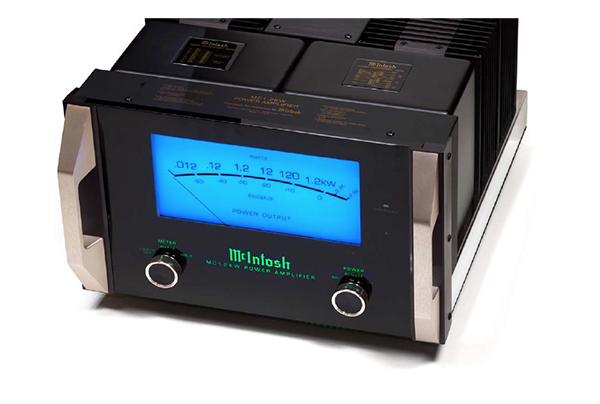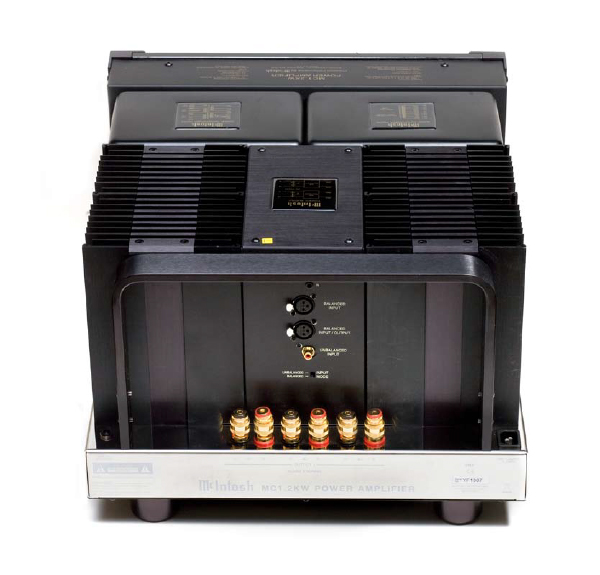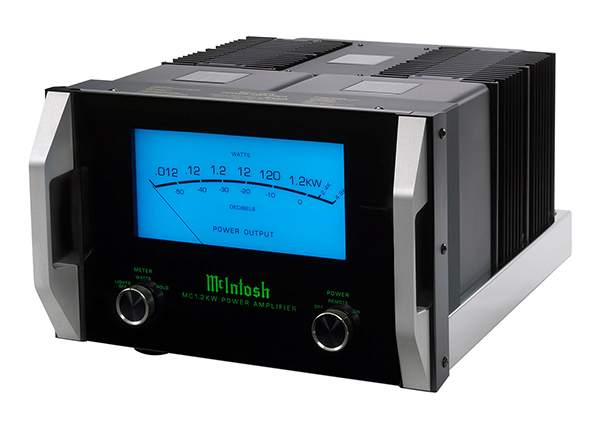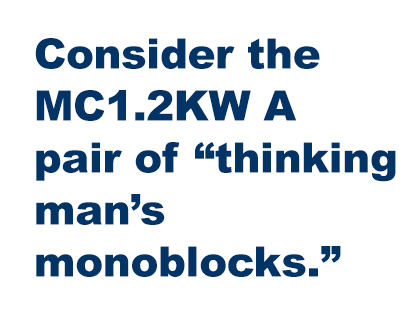The McIntosh MC1.2KW Power Amplifiers Massive Attack
By Jeff Dorgay McIntosh made a big splash a while back with its six-box, 2,000-watt MC2KW power amplifiers. They are very cool, play incredibly loud (if you have enough juice in your power line to let them wind out all the way) and command an impressive presence.
McIntosh made a big splash a while back with its six-box, 2,000-watt MC2KW power amplifiers. They are very cool, play incredibly loud (if you have enough juice in your power line to let them wind out all the way) and command an impressive presence.
Many lovers of the McIntosh brand see them as the Holy Grail. For those who don’t have the space or the budget but still dig those gigantic level meters, there’s a more reasonable alternative: the MC1.2KW. The more manageable MC1.2KW monoblocks tip the scale at only 147 pounds each. They’re still not budget components, but the $25k price tag will leave you with enough money left over from not buying the $70,000 MC2KW’s to assemble a formidable system.
Sporting metered faceplates the same size as the MC 2KW, the MC1.2KWs are attention getters. While many audiophiles love “deep-listening” sessions, nothing says “party on” like the gigantic blue meters, and this is a big part of their charm. Their blue glow floods your listening room like a couple of gigantic lava lamps. You can turn them off. But why?
A direct descendent of the MC1201’s, the MC1.2KW’s have significant electrical and cosmetic upgrades. According to Ron Cornelius, McIntosh product manager, the MC1.2KW “Actually produces closer to 1,600 watts per channel on a test bench, so you have to be careful with this much power on tap!”
Setup
Unless you are a super hero, getting at least one person to help you unpack the MC1.2KWs is a good idea. And be certain that your equipment rack can support at least 150 pounds per shelf.
Thanks to the large lip on the back, they are surprisingly easy to grasp and move around. I wish more manufacturers would provide rear panel handles on amplifiers this heavy.
While not the latest word in aesthetics, a pair of piano dollies come in handy shuttling the MC1.2KW’s between my reference amplifiers, along with the other gigantic amplifiers we had in for review this issue. They’ve since taken up permanent residence on a pair of Finite Elemente amplifier platforms and look very stylish; they beg to be displayed prominently.
Your next concern will be power. These big beasts need a lot of juice to do their thing. You can run a pair on a single 15-amp circuit, but they won’t reach full power. A dedicated 20-amp line
is better, but if you want an effortless 1,200-watt-per-channel experience, you’ll need a pair of 15-amp dedicated lines. McIntosh tech-support head Chuck Hinton recommends, “Each amp needs its own 15-amp line for maximum performance.” While McIntosh lists the maximum current draw at 13 amps, there’s no point in scrimping if you’re getting dedicated power lines run. Go for 20 amp lines and make sure to have it done by a qualified electrician. Ron Cornelius adds a few more tips, stressing the idea of having your wiring in top shape. Double check your power panel’s grounding and make sure all the connections to the panel and outlets are tight. It’s the nature of solid-core copper wire to wiggle loose with time. “If you don’t have solid power going to your system, your line level components will suffer as well.”
 Extended listening with a dedicated 15-amp circuit, a dedicated 20-amp circuit, and dedicated 20-amp circuits for each monoblock reveals that power is your friend. While the amps worked with the single 15-amp line, the circuit breaker blew repeatedly at high volume.
Extended listening with a dedicated 15-amp circuit, a dedicated 20-amp circuit, and dedicated 20-amp circuits for each monoblock reveals that power is your friend. While the amps worked with the single 15-amp line, the circuit breaker blew repeatedly at high volume.
The rest is easy. MC1.2KWs have balanced XLR inputs on the back panel along with RCA inputs and a 12-volt trigger, so it will integrate into any system handily. Due to the use of the legendary McIntosh Autoformers in the output stage, featuring 2-ohm, 4-ohm and 8-ohm taps to connect your speakers. Mc suggests starting with the nominal impedance of your speakers, but a bit of experimentation will yield the best results – sometimes the best match that transfers the most music might be a different tap. My only complaint with the MC1.2KWs, and for that matter all of the McIntosh solid state amplifiers are the dreadful speaker binding posts – they are too small and too close together.
The Sound
The MC1.2KWs immediately take charge. After a few hours warm up with nondescript background music, dropping Joe Harley’s recording of Mighty Sam McClain’s Give it up to Love threw a massive soundstage between my speakers. This record was recorded live to two-track analog tape and when you crank this one up and dim the lights, it sounds like mighty Sam is right there in your listening room (singing in front of a pair of gigantic McIntosh amplifiers in this case…).
With this kind of power at your disposal, big dynamic range helps to create a live feel on recordings with a big dynamic swing and the big Macs never disappointed, whether listening to a full symphony orchestra or Rammstein. You don’t realize just how wimpy your 100-watt per channel amplifier is until you have 1,200 per channel at your disposal. Trust me, you might never want to go back.
Friends listening to my system with the MC1.2KW’s always made the same comment: “Wow, I can’t believe how often those meters jump up around 300-600 watts and we’re not listening that loud.” All the arguments about “tube watts” vs. “transistor watts” vs. “whatever other watts you got” go away, and quickly. It’s big power vs. little power, baby, and if there was ever an argument for size mattering, the MC 1.2KWs settle the score handily.
People often forget that the need for power goes up exponentially as sound pressure level doubles; so that 100-watt-per-channel amp sounds great when you are listening in the one-to-10 watt range because you still have 100 watts or so in reserve, but when you get fast and furious with the volume control, compression sets in quickly and, if you’re not careful, clipping. Still, proceed with care when rocking out because even though it’s tougher to burn out a tweeter with all that clean power, you can run the risk of toasting a crossover when you are pushing the MC1.2KW’s near their limits. That’s when bad things happen to good people.
Power and Control
Next up, some Prince from the Diamonds and Pearls album. The beginning of the track, “Insatiable,” features deep synth bass lines with grunt that usually come across loose and sloppy. The extra power and control of the MC1.2KWs grabs those notes, holds the sustain and stops cleanly. I usually need the help of the JL Audio Gotham in my system to achieve that experience. No longer.
The other aspect of a high-powered amplifier that becomes instantly apparent is the ability to play complex music at relatively high volume levels without the soundstage collapsing. Try this with your favorite piece of densely packed music, whether it is a full symphony or driving rock. This is where the difference between 100 watts per channel and 1,200 per channel is instantly apparent. Though both play fairly loud, when you start to crank the 100-watt amp, everything gets muddy and you lose focus.
If you become the happy owner of a pair of MC1.2KWs, this will be a thing of the past and you might even discover that some of those discs that you thought were compressed just had their peaks rounded off.
During the course of this review, I had the opportunity to use the MC1.2KW’s with about a dozen different loudspeakers, from the Martin-Logan CLX electrostatics to the YG Acoustics Anat II Studios, both of which have low impedance dips and can be problematic to drive. Nothing in my speaker arsenal requires more power than my Magnepan 1.6’s Should you be a Magnepan owner looking for the Holy Grail, nothing lights up a pair of Maggies like the MC1.2KWs. Where the 1.6’s always feel somewhat bass shy in my 16 x 24 foot room, with the Mac amps they sounded like I had added a subwoofer to the system.
The dynamics were amazing and again, all who listened were surprised how easy it was to use up 1,000 watts per channel. It’s worth mentioning that no matter how hard I pushed these amplifiers, even when driving the Magnepans very loud, the MC1.2KW’s never got more than slightly warm to the touch.
Having just spent time with the MC252 amplifier that we reviewed very favorably, the MC1.2KW’s are in a completely different league. The MC252 is an excellent amplifier and a great value, but it does not have the delicacy and clarity that the MC1.2KW has. No matter what the listening level, these are some pretty special amplifiers with the slightest bit of warmth and body to the overall presentation. I doubt that anyone will ever refer to these amplifiers as “sterile solid-state.”
Big Power, Big Meters, Big Fun
At $25,000 a pair, this is not an idle purchase, even for the well-heeled. But if you want a pair of amplifiers that will never run out of juice or require you to buy a futures contract on output tubes, the MC1.2KW could be your Holy Grail. So dim the lights, put your favorite disc on and let em’ rip.
 The McIntosh MC1.2KW Monoblocks
The McIntosh MC1.2KW Monoblocks
$24,995/pair



